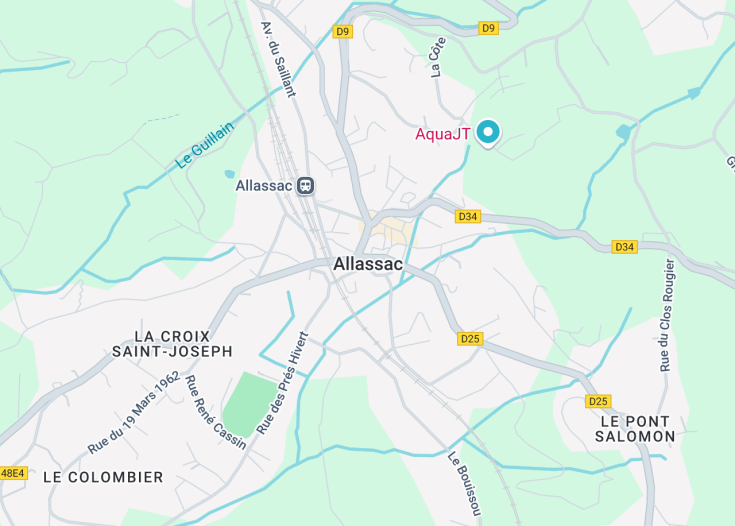Nestled in the picturesque landscape of Nouvelle-Aquitaine, Allassac is a charming commune in France that boasts a rich historical heritage and stunning natural beauty. Known for its medieval architecture, including the 11th-century Old Bridge and the Church of Saint John the Baptist, Allassac provides a serene escape with its breathtaking views over the Vézère valley. The area is famed for its slate production, adding to the rustic and authentic feel of this beautiful destination.
Visiting Allassac? Make sure to explore its vibrant local markets. They are perfect for experiencing the region’s culinary delights and artisan crafts.
Planning a trip to Allassac? Don’t miss a walk along the River Vézère for a tranquil experience and picturesque photo opportunities.
Top things to do & see in Allassac
Select the following sights and activities to discover best tickets and tours available in Allassac.
Allassac: The Gateway to the Dordogne Valley
| Country | France |
| Time in Allassac | GMT+1 |
| Language spoken | French |
| Population | 3,400 (City of Allassac Official Statistics, 2023) |
| Currency | Euro (€) (EUR) |
| Airports |
|
Allassac is a scenic commune nestled in the Nouvelle-Aquitaine region of southwestern France, best known for its captivating charm and rich history. Located by the Vézère River, Allassac is characterized by its sloping grapevines, historic stone houses, and panoramic views of the rolling Limousin countryside. Known as the ‘Tile Capital’ for its outstanding terra cotta tiles, the town’s architecture beautifully showcases this heritage. Cultural immersion is inevitable when visiting, with medieval structures and numerous vineyards offering visitors a taste of its history and viticultural prowess. An avid blend of culture, history, and natural beauty make Allassac not only a pivotal destination for history enthusiasts but also an appealing haven for nature lovers and food aficionados looking to explore the subtleties of French provincial life.
Where is Allassac?
Allassac is situated in the scenic heart of Corrèze department, part of France’s Nouvelle-Aquitaine region.
Distances:
| Route | Distance by car | Time by car |
|---|---|---|
| Paris to Allassac | 276 miles (444 km) | Approx. 4 hours 50 minutes |
| Bordeaux to Allassac | 133 miles (214 km) | Approx. 2 hours 15 minutes |
| Toulouse to Allassac | 145 miles (233 km) | Approx. 2 hours 30 minutes |
What is Allassac famous for?
Allassac is renowned for its rich history in terra cotta tile making, its vibrant local vineyards, and its picturesque medieval architecture that captivates visitors seeking both beauty and historical depth.
History
Prehistoric to Medieval Times (up to 500 AD)
Allassac, located in the picturesque region of Nouvelle-Aquitaine in France, boasts a rich history that dates back to prehistoric times. Archaeological finds in the area suggest early human settlements, with various tools and artifacts pointing to occupation during the Paleolithic and Neolithic periods. As civilizations advanced, the locale witnessed the influence of the Gauls, and later the Romans, who integrated Allassac into their extensive empire, leaving behind remnants of Roman villas and structures.
The Middle Ages (500 AD – 1500 AD)
The medieval era significantly shaped Allassac, with the construction of its formidable church and castle during this period. The strategic placement along important trade routes made Allassac a pivotal location in regional politics and commerce. The town’s architecture from this era, including the stone bridges and fortified buildings, highlights the defensive importance and the wealth Allassac accumulated through trade and agriculture.
Modern Era (1500 AD to Present)
In more recent history, Allassac has transitioned from a mainly agrarian society to embracing modernity while preserving its historical roots. The town’s adaptation to the changes brought by the Industrial Revolution and the subsequent development in the 19th and 20th centuries are evident in the renovated facades and expanded infrastructure. Today, Allassac is celebrated not only for its historical and architectural heritage but also for its vibrant culture and as a focal point for local and regional festivals which attract numerous visitors annually.
Visit Allassac
What to see and do in Allassac
Visiting Allassac offers a rich tapestry of culture and history wrapped in the scenic beauty of the Nouvelle-Aquitaine region. The town’s historical heart is dominated by the impressive 12th-century church and the remains of the medieval castle, offering insight into the area’s feudal past. Wander through the old town’s narrow lanes lined with restored traditional houses. Nature enthusiasts will appreciate the nearby Vézère Valley, perfect for hiking and capturing panoramic views of the lush landscape. Cultural activities abound, including guided tours that delve into Allassac’s historical development and artisan workshops showcasing local crafts like pottery and tapestry making.
Annual Festivals in Allassac
Allassac’s community is vibrant with numerous events that celebrate its cultural heritage and the arts. Prominent among these is the ‘Fête de la Saint Jean’, held annually in June, which features live music, traditional dances, and firework displays. Autumn brings the ‘Foire de la Pomme et de la Châtaigne’ in October, a festival celebrating local apple and chestnut harvests.
Best time to visit Allassac
The ideal time to visit Allassac is from late spring to early autumn, particularly between May and September, when the weather is most pleasant. This period offers a comfortable climate for exploring the outdoor historical sites and participating in the local festivals.
Is Allassac worth visiting?
Allassac, with its blend of rich history, captivating architecture, and thriving cultural scene, presents a compelling destination. Visitors can explore well-preserved medieval structures, enjoy local events that showcase the area’s heritage, and indulge in outdoor activities set against a backdrop of stunning natural beauty. However, those looking for bustling city life might find Allassac’s serene pace less thrilling. The town’s remote location may also pose accessibility challenges for some travelers. Nonetheless, for those drawn to historical richness and pastoral charm, Allassac is undoubtedly worth considering.









